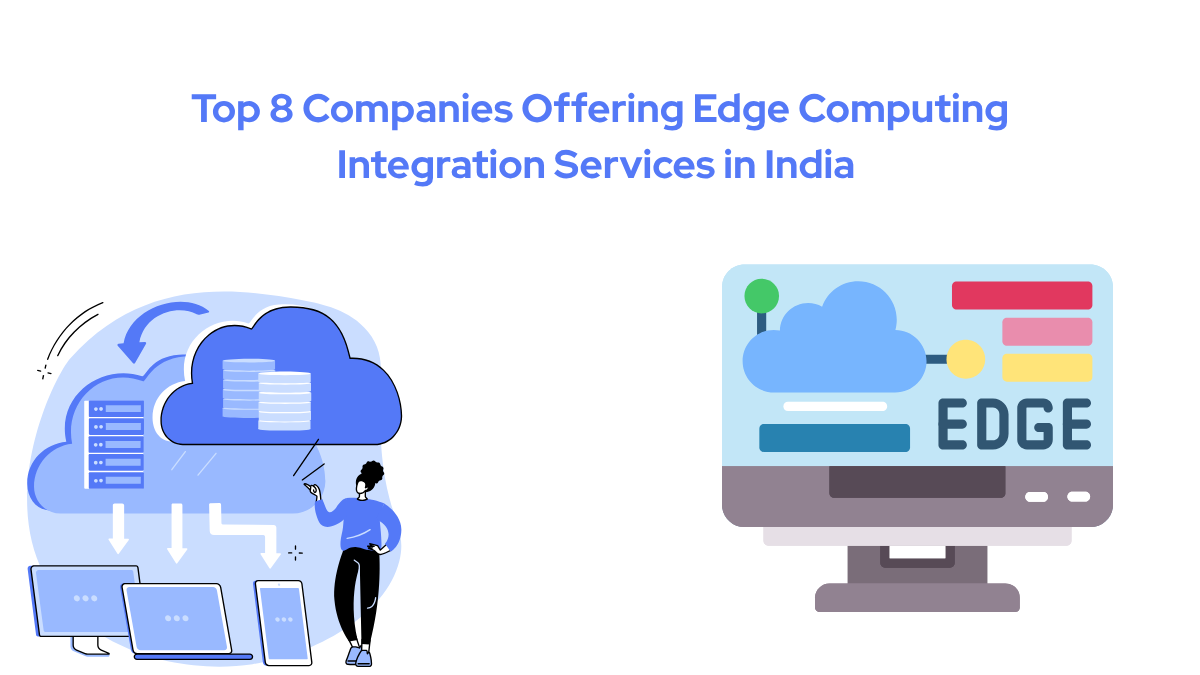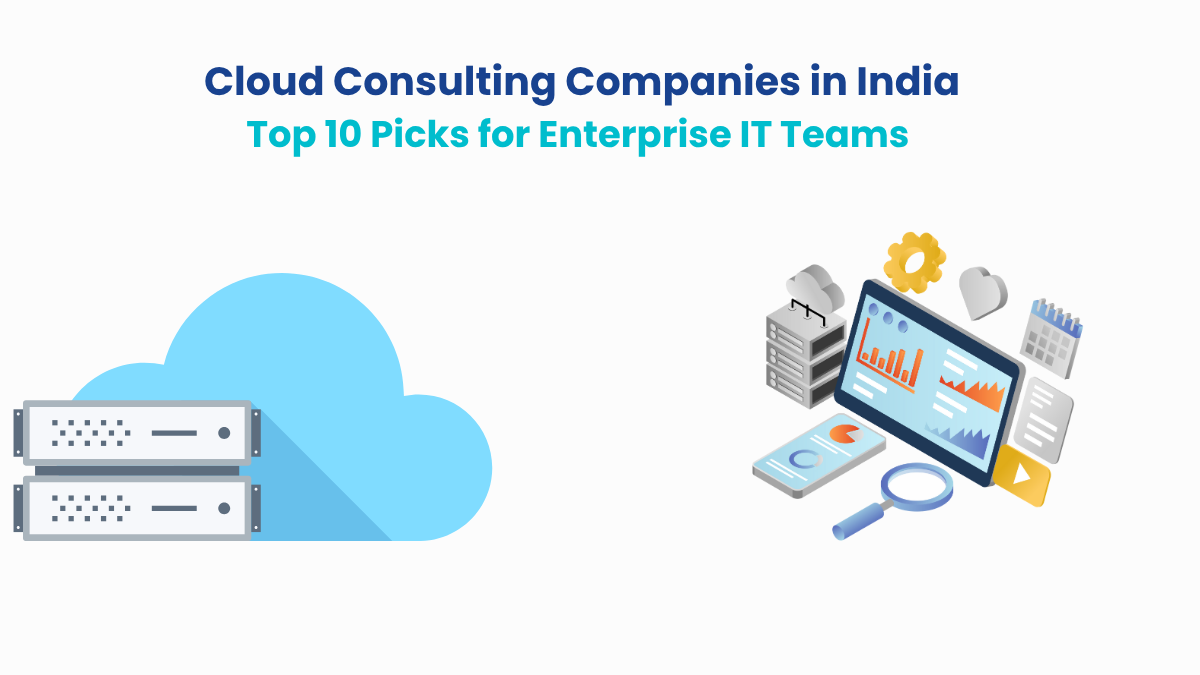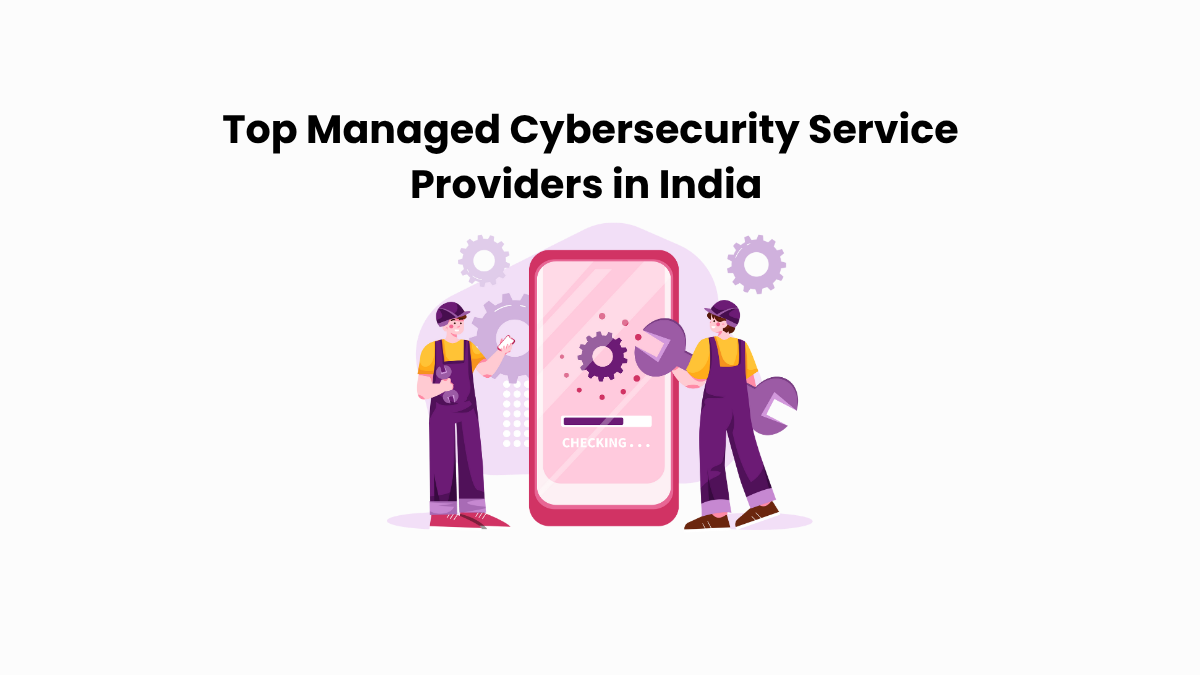Edge computing sounds simple. Put computing power close to where data is generated. Make faster decisions. Reduce cloud costs.
But here is the hard truth. Most enterprise edge deployments fail, not because the hardware is wrong, but because the integration is broken.
Without proper integration, your edge setup becomes a liability. Devices collect data but cannot sync with the cloud. Security policies break down across environments. Operational systems drift apart. The edge becomes a series of isolated silos instead of an intelligent network.
That is why enterprises today are not just investing in edge. They are searching for partners who understand how to connect the edge with the rest of their ecosystem.
In this article, we look at the leading companies in India that specialize in edge computing integration services. These are the teams that make the edge real, reliable, and ready for scale. But how do you choose them? Let’s find out!
Key Factors to Look For in an Edge Computing Integration Partner
Not every company that claims to “do edge” can integrate it well. And in most enterprise deployments, integration is where the real problems begin. That’s why, when it comes to integration, you need to look beyond feature lists or vendor logos. Here are the factors that truly matter:
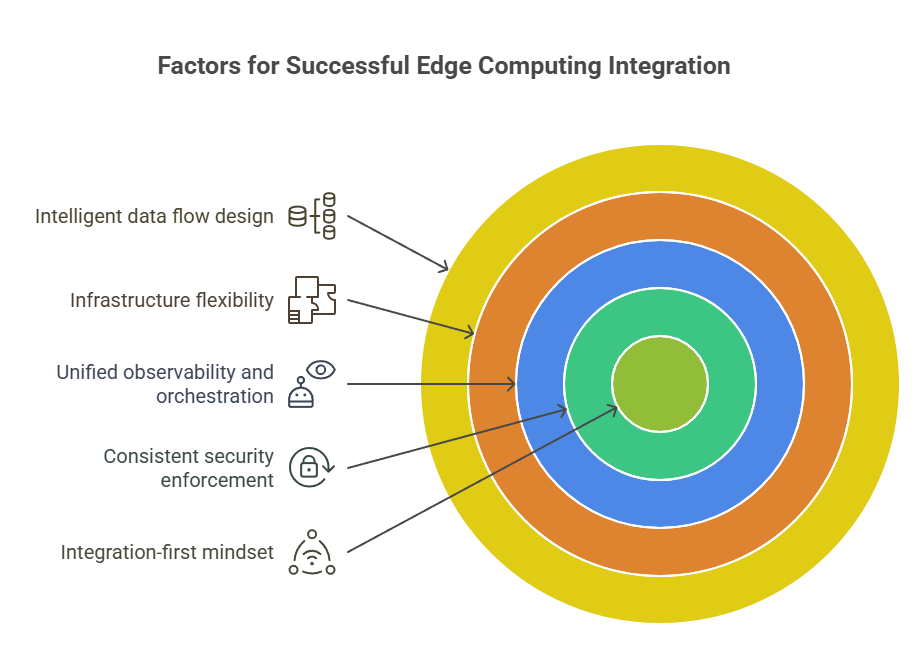
#1. Integration-first mindset: The real complexity of edge is not in setting it up. It is in making it talk to everything else. Your partner must know how to wire edge devices into cloud platforms, on-prem data lakes, SOC dashboards, and legacy systems without introducing fragility.
#2. Consistent security enforcement: Edge nodes often operate outside the central IT perimeter. If your provider cannot extend access control, encryption, and policy enforcement to the edge, you are not scaling the edge, but multiplying attack surfaces. The best partners build security from node to core.
#3. Unified observability and orchestration: Without central visibility, edge becomes unmanageable. You need partners who deliver telemetry, remote management, and lifecycle control across every site. Otherwise, each new deployment adds complexity without adding value.
#4. Infrastructure flexibility: Edge deployments vary based on environment, say retail branches, smart factories, or logistics hubs. A good partner builds modular, vendor-agnostic environments that adapt to different site conditions and business goals. Rigid, single-vendor approaches will not survive long.
#5. Intelligent data flow design: Not all data belongs in the cloud. A true integration partner understands how to build policies for local processing, selective sync, and time-sensitive routing. They reduce costs and improve performance by knowing what to process where.
#6. Vertical experience that shows: Edge is not one-size-fits-all. A banking use case demands compliance-grade security. A factory floor demands deterministic latency. The best partners have solved these problems before, at scale, in your environment, not just in the lab.
The right partner does not just deploy edge. They embed it into the bloodstream of your enterprise.
Now that we have covered what truly matters in edge integration, the next step is knowing who can deliver it.
Below are some of the companies that bring serious capability when it comes to making edge work inside a real enterprise environment.
Let us start with a company that has made system integration its core strength – Datacipher.
#1. Datacipher
Datacipher specializes in integrating edge computing into enterprise ecosystems where uptime, data integrity, and real-time responsiveness are critical. Unlike platform-first vendors, Datacipher operates as a system integration expert. They specialize in designing edge deployments that work in harmony with cloud platforms, legacy infrastructure, and enterprise-grade security systems.
With a track record across verticals like manufacturing, BFSI, and healthcare, Datacipher delivers edge architectures that support AI inference, high-performance visualization, and IoT data processing. They do this while ensuring compliance, observability, and long-term scalability. The focus is not just deployment, but end-to-end integration that aligns with real operational goals.
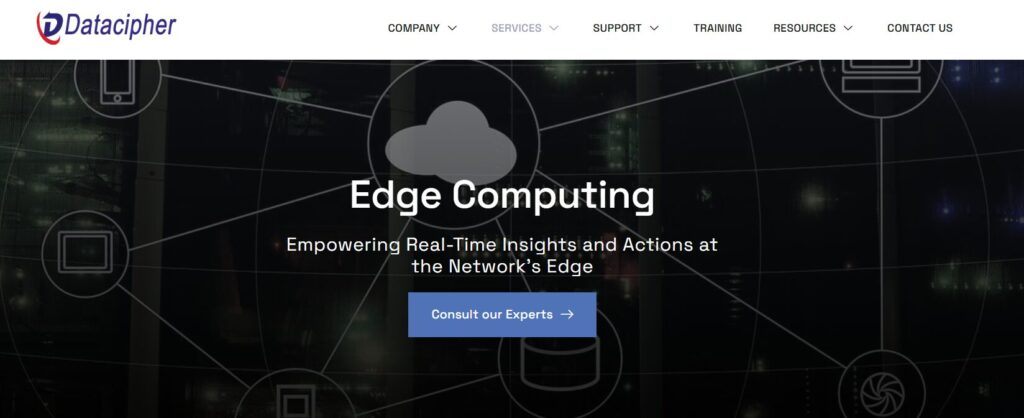
Source – Datacipher
Here are the Edge Integration capabilities Datacipher offers:
- Seamless Integration with Cloud and On-Prem Infrastructure: Ensures edge systems connect smoothly with existing enterprise platforms without disrupting workflows or security policies.
- Scalable, Real-Time Workload Processing: Supports AI training, HPC, and low-latency decision-making through localized compute infrastructure tuned for each site.
- Security and Compliance Built-In: Embeds access control, encryption, and data governance directly into the edge layer to align with enterprise security frameworks.
Multicloud and Vendor-Agnostic Architecture: Designs edge deployments that remain flexible and interoperable across various OEM ecosystems. - Centralized Monitoring and Policy Management: Delivers tools and practices for unified visibility across edge nodes, enabling proactive performance tuning and risk mitigation.
- End-to-End Deployment and Support: From planning and rollout to lifecycle management, Datacipher provides ongoing technical and operational assistance across distributed environments.
Datacipher is best suited for enterprises that need real-time, secure edge deployments tightly integrated with cloud, legacy, and security systems. Their integration-first approach helps reduce long-term costs by avoiding vendor lock-in, minimizing rework, and ensuring the architecture scales without operational debt.
CISO Insight: One of the easiest mistakes in edge deployments is assuming you’ll maintain control later. But if you don’t design for visibility and orchestration from the start, you’re left firefighting node by node. Integration-first partners fix that by building in control as part of the foundation, not an afterthought.
#2. Wipro
Wipro provides edge computing integration through pre-structured solution stacks built around partner technologies. Instead of designing architectures from scratch, it offers modular edge deployments using frameworks like Wipro Edge Cloud and BLUE, powered by IBM Edge Application Manager.

Source – Wipro
Their approach is platform-enabled, combining lifecycle automation, containerized orchestration, and programmable infrastructure. Integration services are layered over these platforms to support deployments across private 5G, IoT, and hybrid environments. Wipro also includes AIOps and observability tooling to maintain control across distributed edge nodes.
Wipro is a strong fit for enterprises seeking large-scale edge rollouts using pre-validated stacks. It is especially useful in industries where alignment with telecom providers or global technology ecosystems is a strategic requirement.
CISO Insight: The challenge with edge is not just what you build, but what you have to maintain. Pre-validated platforms reduce time to deploy, but only if observability and policy controls are built in from day one. When edge environments scale fast, having automation and monitoring as part of the base architecture is not a luxury, it is the safety net.
#3. Infosys
Infosys brings edge integration through its Multi‑Access Edge Computing (MEC) and S.M.A.R.T Edge frameworks. They offer prebuilt modules for compute, storage, container orchestration, and network automation. These are designed to deploy real‑time edge workloads swiftly.
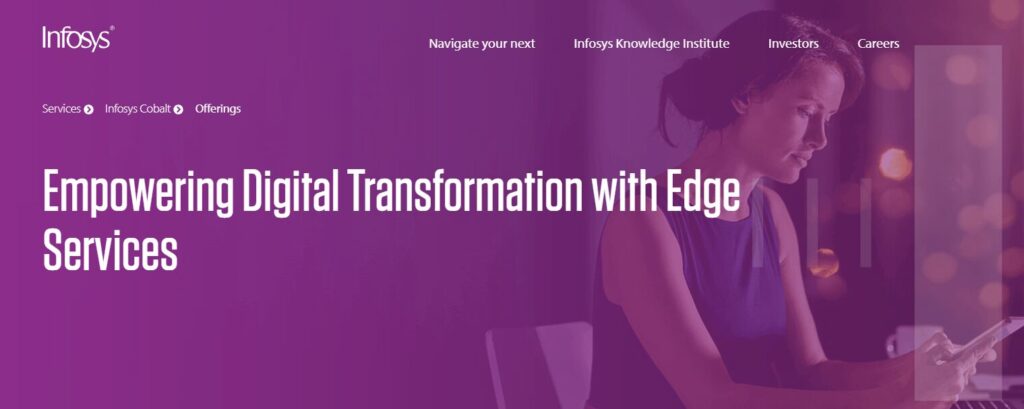
Source – Infosys
Their MEC offering supports wireless connectivity, VNF migration, NFVI setup, and multi‑access integration with cloud, RAN, and OSS systems. The S.M.A.R.T Edge stack combines containerized local compute, programmable networks, and AI/ML automation to ensure low latency, security, and reduced operating cost.
Infosys also offers Private 5G‑as‑a‑Service with integrated MEC capabilities for high‑bandwidth, low‑latency edge use cases. Their edge stack is designed to accelerate rollout in sectors such as telecom, utilities, and energy, particularly where AI-powered edge use cases, like drone inspection or remote analytics, are required.
CISO Insight: Edge deployments that span telco, cloud, and enterprise layers often fail at the seams. Without a well-orchestrated stack, latency creeps in, and security enforcement gets fragmented. Modular edge frameworks help, but only when integration across systems is planned early and tested under load, not just in the lab.
#4. HCLTech
HCLTech offers edge computing integration through its EdgeLITy framework, built on validated solution modules. It is a platform-enabled model, combining pre-integrated architecture with layered integration services for enterprise deployment.
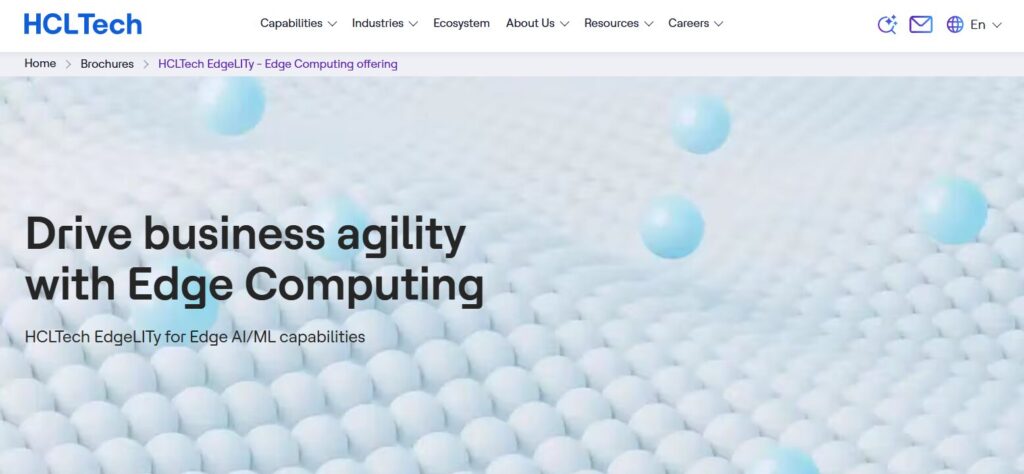
Source – HCLTech
EdgeLITy supports hybrid cloud environments and helps unify IT and OT systems at the edge. HCLTech focuses on central visibility, lifecycle automation, and secure rollout across remote and industrial sites.
Its approach is structured and scalable, making it suitable for enterprises needing control across many locations. The platform supports major cloud providers and includes management tooling to reduce deployment risk.
HCLTech’s edge services are well-suited for regulated industries like manufacturing, energy, and financial services, where operational stability and compliance are critical.
CISO Insight: When edge expands across dozens of locations, consistency becomes more important than customization. A structured rollout with unified controls often prevents the slow drift that leads to security gaps and compliance issues. The right platform makes good habits repeatable.
#5. Accenture
Accenture supports edge adoption through comprehensive consulting and integration services. It helps enterprises extend cloud capabilities to edge environments, enabling real-time applications like smart manufacturing and robotics.

Source: Accenture
Their services include modernizing infrastructure, implementing AI and container-based edge orchestration, and integrating edge with cloud systems for unified security and operations.
Accenture emphasizes aligning edge with the enterprise data strategy. Their solutions support rapid decision-making, secure processing, and reduced latency. This is especially critical in industries with high operational or safety demands.
This makes Accenture well-suited for organizations looking to reimagine business processes through edge innovation while maintaining governance, data control, and hybrid-cloud consistency.
CISO Insight: One common mistake with edge computing is underestimating how quickly configurations drift across distributed nodes. To stay ahead, security leaders should prioritize centralized policy enforcement and automated compliance checks, even in low-connectivity zones. This prevents silent failures and keeps your edge secure by design.
#6. NTT DATA India
NTT DATA India delivers full-stack edge computing services grounded in real-world enterprise use cases. They combine edge infrastructure, private 5G, IoT, and edge AI into unified frameworks aimed at low latency, enhanced security, and OT resilience.
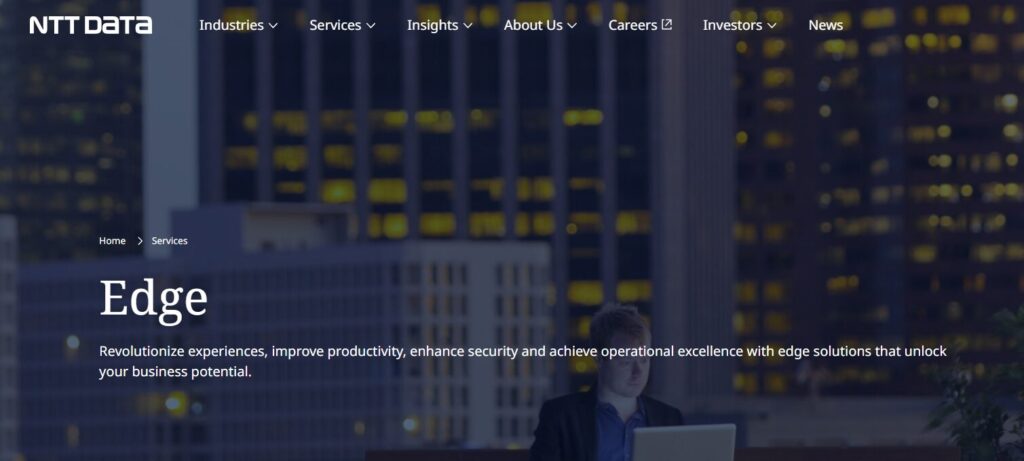
Source – NTT Data
Instead of building custom edge solutions from scratch, NTT DATA offers Edge-as-a-Service packages that integrate compute nodes with sensor networks, private 5G, and centralized management. They emphasize merging IT and OT systems, ensuring uninterrupted operations in environments like manufacturing plants and smart facilities
Their approach is platform-enabled. This means they use validated modules for deployment, orchestration, and lifecycle governance. Clients also benefit from managed services that enable real-time processing, private network support, and unified policy control across distributed sites.
NTT DATA is best suited for organizations seeking turnkey edge solutions that balance hardware, connectivity, AI, and security in regulated or industrial settings.
CISO Insight: One of the most overlooked risks in edge rollouts is weak alignment between IT and OT security postures. Operational teams often treat edge nodes as isolated devices, while IT expects centralized visibility and control. This disconnect creates blind spots. A strong edge integration strategy closes that gap, by embedding unified policy enforcement, continuous monitoring, and cross-domain incident workflows from day one.
#7. L&T Technology Services
L&T Technology Services delivers edge integration through its EDGYneer device-management platform and Edge-AI frameworks built with Intel. EDGYneer enables secure device onboarding, over-the-air updates, and centralized management of remote edge assets.
The platform also supports containerized analytics, data aggregation, firmware updates, and security controls across heterogeneous devices
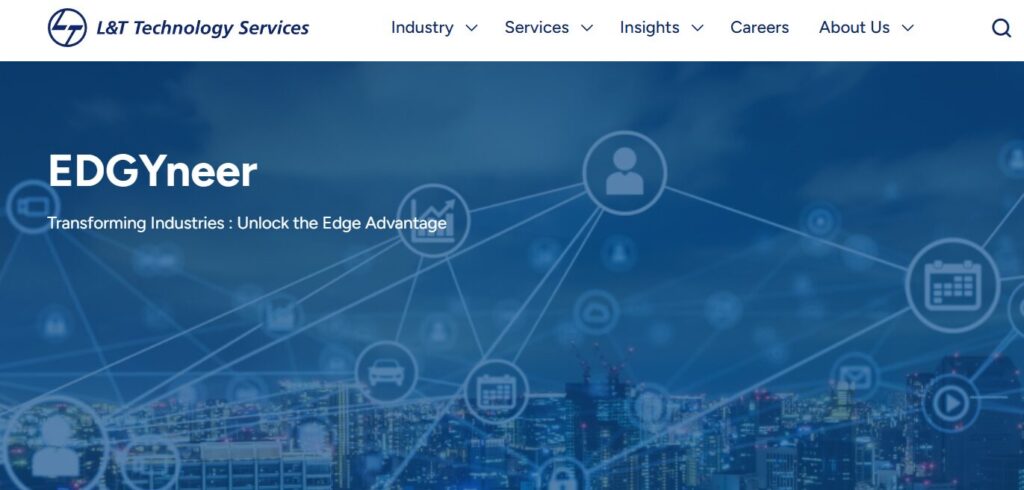
Source – L&T
L&T also collaborates with Intel to enable real-time AI inference using OpenVINO for traffic management and industrial use cases. This Edge-AI framework processes data at the network edge, supporting smart-city systems and vehicle-to-everything environments.
The combination of EDGYneer and Edge-AI modules makes L&T ideal for enterprise edge deployments that need device-level control and real-time intelligence.
CISO Insight: One of the most common risks in edge environments is the silent sprawl of unmanaged devices. Over time, this leads to outdated firmware, weak credentials, and inconsistent policy enforcement. Embedding zero-trust principles at the edge, while starting with automated onboarding and continuous telemetry can prevent these issues before they escalate.
#8. Microland
Microland provides edge computing integration primarily through its Industrial IoT (IIoT) and network services platforms. As a Cisco IoT partner, Microland integrates OT and IT securely via edge monitoring architectures that work with ICS, SCADA, and DCS systems. They also utilize Microsoft Azure IoT technology and PTC ThingWorx to create scalable, multi-cloud edge solutions.

Source – Microland
Their edge approach combines device-level analytics, secure network connectivity, and centralized telemetry using their Intelligeni AIOps platform. This enables real‑time visibility, performance tracking, and proactive incident management across distributed edge ecosystems.
Microland is best suited for enterprises needing industrial-grade edge deployments in manufacturing, smart facilities. It is also suitable for distributed OT-heavy environments where harmonious IT‑OT convergence and continuous monitoring are critical.
CISO Insight: Edge projects often stall at the IT–OT intersection. Teams struggle to align security policies across factory floors, field devices, and cloud interfaces. One simple shift can prevent this: Start with a shared risk framework that maps device-level access, data flow, and incident response across the entire edge stack.
When OT teams know where the boundaries are, and IT knows how to enforce them, the integration becomes not just possible but sustainable.
At the end of the day, edge computing integration is not just about deploying nodes or containers. It’s about aligning every technical decision with real enterprise priorities. The eight companies above approach that equation differently.
However, choosing the right partner depends on where you are in your edge journey, and which risks you’re willing to own.
But no matter who you choose, there are common traps that derail edge initiatives. The kind that don’t show up on a proposal. However, they come at a cost in downtime, drift, or dead-end architectures. Let’s next look at what to avoid.
Where Most Edge Integration Efforts Go Wrong?
Let’s be honest. Choosing the right edge integration provider isn’t just about who offers the most features. It’s about who truly understands the realities on the ground. Because edge isn’t a checklist item. It’s a live environment with real constraints.
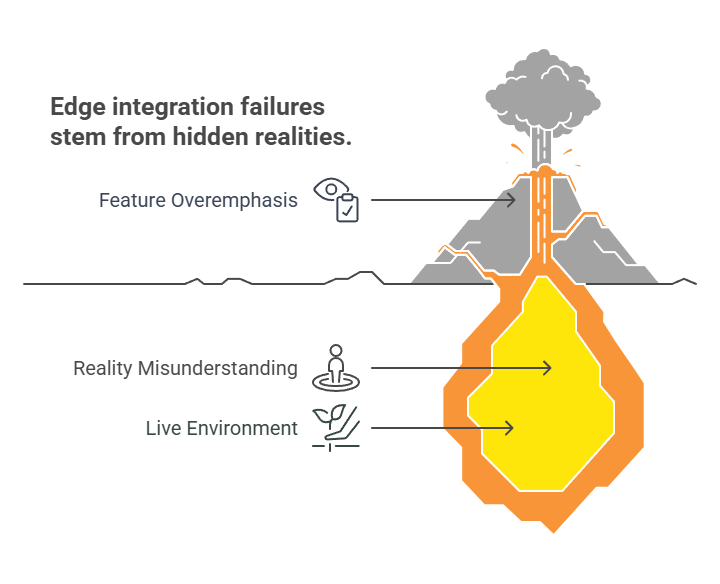
Here’s where most enterprise edge rollouts start to unravel:
1. Misunderstanding what “integration” really means
Too often, edge is treated as a bolt-on – nodes deployed, containers running, dashboards online. But unless those edge deployments are aligned with enterprise workflows, security policies, and cloud backbones, you’re just scattering compute power with no orchestration.
2. Applying cloud thinking to edge environments
Cloud assumes stable connectivity, unified control, and elastic scale. Edge operates in the opposite direction. This results in low bandwidth, physical isolation, and hard latency deadlines. If your architecture doesn’t reflect that, reliability suffers fast.
3. Treating every location the same
No two edge sites are identical. One may sit in a hospital with strict compliance. Another in a factory with flaky power. Integration requires adapting to each site’s constraints, not cloning blueprints.
4. Ignoring operational lifecycle
It’s easy to launch a pilot. It’s hard to patch, monitor, and scale 200 edge nodes over three years. Most failures happen not at go-live, but six months in when visibility fades and teams fall back on manual fixes.
5. Skipping the “what if” planning
What happens if a node fails mid-process? Or if compliance standards change in one geography? Edge integration needs to be proactive, not reactive, and your vendor must design for the unknown.
These are not fringe cases. These are the reasons so many edge projects stall after the pilot stage. That’s why it’s not just about selecting a vendor. It’s about choosing a partner that solves your edge, not just the edge.
To deepen your understanding of how visibility and continuous discovery can support successful edge deployments, especially in environments with growing attack surfaces, explore our eBook ‘10 Essential Use Cases for Attack Surface Management’. It highlights proactive ways to secure complex infrastructures before they become liabilities.

And that’s where Datacipher leads.
Why Datacipher Stands Out in Edge Computing Integration?
Most system integrators approach edge as an extension of the cloud.
However, Datacipher approaches it as a frontline computing layer that must be deeply integrated with your business logic, security posture, and operational model. We don’t just deploy edge nodes. We make them work for you, wherever you are in your transformation journey.
With a track record of solving edge challenges across sectors like manufacturing, healthcare, and BFSI, we brings integration-first thinking, not vendor-first agendas.
Whether you’re building near-factory AI inference systems, decentralizing compliance-sensitive workloads, or ensuring uptime across fragmented geographies, our team engineers solutions that are not only secure and scalable, but also sustainable.
Here’s what sets us apart from other service providers:
- Enterprise-Aligned Architectures: Our solutions are custom-built for integration with your existing hybrid environments, whether cloud, legacy, or on-prem.
- Real-Time Workload Optimization: We fine-tune edge infrastructure for AI, HPC, and data visualization use cases, delivering low-latency performance at scale.
Multicloud-Ready and Vendor-Agnostic: Our deployments remain interoperable across hyperscalers and OEM stacks, avoiding future lock-ins. - Security and Observability by Design: From day one, we embed security controls, orchestration, and telemetry to minimize drift and maximize control.
To give you a recent instance, a leading logistics provider was struggling with real-time package tracking across multiple Tier-2 cities. Their legacy systems couldn’t handle the latency or data processing demands.
When they came to us, we implemented a federated edge architecture that localized compute at each distribution hub. This reduced the processing lag by 79% and enabled predictive route optimization. The solution also integrated seamlessly with their existing ERP and analytics stack, avoiding any disruption to operations.
If you’re on the lookout for a partner who can translate edge into business advantage, we are here to help. Talk to our edge experts today and explore how we can co-design a solution that actually works for your enterprise environment.
Frequently Asked Questions
#1. How is edge computing different from cloud computing?
Cloud centralizes data processing in remote data centers. However, edge shifts that compute power closer to the data source – on-site or near-site – reducing latency and enabling faster decisions.
#2. What are the biggest risks in poorly implemented edge deployments?
Lack of visibility, inconsistent security policies, and integration failures are common pitfalls. Over time, these lead to shadow infrastructure, unpatched systems, and rising operational costs. Without architectural foresight, edge becomes a liability, not a capability.
#3. Can edge solutions work with legacy infrastructure?
Yes, but only with the right integration strategy. Enterprises need platforms and partners that can bridge old and new systems without disrupting operations. Edge doesn’t require replacing legacy, it requires extending its utility.
#4. Is edge computing viable for mid-sized businesses, or is it only for large enterprises?
It is absolutely viable. Modular deployments and pay-as-you-scale models make edge computing increasingly accessible. Mid-sized firms can also leverage edge to reduce latency, improve automation, and compete on real-time responsiveness, without massive upfront investments.
#5. What’s the role of 5G in edge computing integration?
5G amplifies edge performance with ultra-low latency and high bandwidth. It allows real-time workloads like autonomous systems, AR/VR, and remote diagnostics to function smoothly. For mobile and distributed deployments, 5G is a key enabler.

